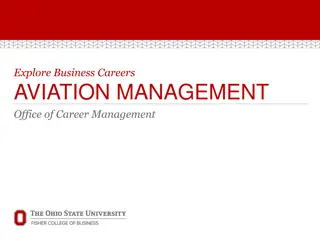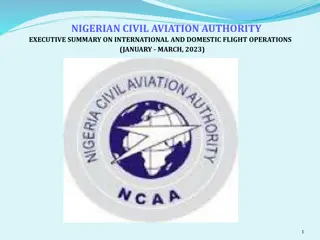The Lessons of Ethiopian Airlines: Aviation Symposium Insights
Exploring the lessons learned from Ethiopian Airlines accidents through a series of webinars in April 2019, this article discusses ongoing investigations, international aviation standards, and key timelines. Experts delve into the accidents involving Lion Air and Ethiopian Airlines, highlighting the impact on the aviation industry and the importance of adherence to safety protocols. Various agencies, including the ICAO and FAA, are actively involved in analyzing the incidents to enhance air travel safety globally.
Download Presentation

Please find below an Image/Link to download the presentation.
The content on the website is provided AS IS for your information and personal use only. It may not be sold, licensed, or shared on other websites without obtaining consent from the author. Download presentation by click this link. If you encounter any issues during the download, it is possible that the publisher has removed the file from their server.
E N D
Presentation Transcript
The Lessons of Ethiopian AirlinesSo Far The Aviation Symposium Webinar Series APRIL 2019 WWW.LECLAIRRYAN.COM
Presenters Mark Dombroff Morgan W. Campbell David K. Tochen 2
The Accidents Lion Air Flight 610, PK LQP October 29, 2018 Java Sea/189 fatalities Ethiopian Airlines Flight 302, ET-AVJ March 10, 2019 Bishoftu/157 fatalities 3
Selected Timeline October 29, 2018: Lion Air Accident November 6-7, 2018: FAA issues Emergency AD regarding 737 Max regarding runaway stabilizer. Boeing issues Flight Crew 737 Operations Manual Bulletin. Selected Timeline November 28, 2018: Lion Air Preliminary Report Issued March 10, 2019: Ethiopian Airlines accident March 13, 2019: Max aircraft grounded by FAA March 14, 2019: - Ethiopian Accident Investigation Bureau can t read out recorders German Federal Bureau of Accident Investigation can t read out recorders UK Air Accidents Investigation Branch considered. BEA given recorders - - - March 21, 2019: Ethiopian Airlines pilots had been trained regarding procedures in Emergency AD April 4, 2019: Ethiopian Airlines Preliminary Report Issues 4
What Investigations Are Ongoing? Accident investigations Lion Air Ethiopian Airlines US Department of Justice FAA Special Certification Review DOT Investigation DOT IG Investigation US Congress 5
International Civil Aviation Organization (ICAO) Chicago Convention on International Civil Aviation, 1944. Establishment of the International Civil Aviation Organization (ICAO), an agency of the United Nations, upon ratification of the Convention in 1945. As of January 2019, there are 192 ICAO members. ICAO is headquartered in Montreal. 6
Annex 13 Annex 13 to the Chicago Convention sets forth international standards and recommended practices for the notification, investigation, and reporting of civil aircraft accidents and incidents. In major respects, the NTSB s standards and practices for aviation accident and incident investigations are fully consistent with those specified in Annex 13. Annex 13 applies in two situations: an overseas manufactured, registered, or operated aircraft is involved in an accident or incident in the United States or its possessions. a U.S.-manufactured, registered, or operated aircraft is involved in an accident or incident in the territories of another country. The investigation of an airplane crash occurring in international waters falls under the jurisdiction of the airplane s country of registry. 7
Annex 13 (continued) If an accident or serious incident occurs in a foreign State (country) involving a civil aircraft of U.S. Registry, a U.S. operator, or an aircraft of U.S. design or U.S. manufacture, where the foreign state is a signatory to the ICAO Convention, that state (known as the state of occurrence ) is responsible for the investigation. Ongoing investigation of Lion Air Flight 610 by National Transportation Safety Committees Directorate General of Civil Aviation. Ongoing investigation of Ethiopian Airlines (ET) Flight 302 by the Aircraft Accident Investigation Bureau, Ministry of Transport, Federal Democratic Republic of Ethiopia. 8
Annex 13 (continued) The NTSB, in coordination with the U.S. Department of State, represents the United States in accident investigations in a foreign country and designates a qualified agency employee to serve as the Accredited Representative to participate in the foreign investigation and assist the investigator-in-charge (IIC) of the investigation. Various organizations with technical knowledge and expertise serve as Technical Advisors to assist the NTSB Accredited Representative in the investigation (e.g., FAA, the manufacturer of the aircraft or major aircraft components). Various organizations with technical knowledge and expertise serve as Technical Advisors to assist the NTSB Accredited Representative in the foreign investigation (e.g., FAA, manufacturer of the aircraft, manufacturers of major aircraft components). 9
Who Investigates Indonesian National Transportation Safety Committee Ethiopian Accident Investigation Bureau Part of Ethiopian Civil Aviation Authority 3 investigators $89,000 budget 10
Roles of Accredited Representatives and Technical Advisors - Annex 13 authorizes Accredited Representatives and Technical Advisors to: - visit the scene of the accident; - examine the wreckage; - obtain witness information and suggest areas of questioning; - have full access to all relevant evidence as soon as possible; - receive copies of all pertinent documents; - participate in read-outs of recorded media; 11
Roles of Accredited Representatives and Technical Advisors (continued) participate in off-scene investigative activities such as component examinations, technical briefings, tests, and simulations; participate in investigation progress meetings, including deliberations related to analysis, findings, causes, contributing factors and safety recommendations; make comments on draft versions of factual reports, preliminary reports, and final accident/incident reports. 12
What Happened? . . . What Did He Say? Cockpit Voice Recorder Flight Data Recorder 13
Supervision of Technical Advisors Technical Advisors work at the direction and under the supervision of the NTSB Accredited Representative. Technical Advisors are subject to NTSB regulatory prohibitions regarding the dissemination of investigative information (49 C.F.R. 831.13) while working under the supervision of the NTSB accredited representative. Confidentiality Media rules 14
Final Accident Report by the State of Conducting the Investigation Under Annex 13, the State conducting the investigation must send the draft version of the final report (including proposed safety recommendations) to: the State that instituted the investigation; the State of Registry; the State of the Operator; the State of Design; the State of Manufacture; any other State that participated in the investigation. 15
Final Accident Report by the State of Conducting the Investigation (continued) States receiving the draft report may submit comments with 60 days to the State conducting the investigation. States receiving the draft report can submit the draft report to their Technical Advisors for their input. If the State conducting the investigation receives comments, it shall either amend the draft final report to include the substance of the comments received or, if desired by the State that provided comments, append the comments to the Final Report. 16
Release of the Final Accident Report The State conducting the investigation of an accident or incident shall make the Final Report publicly available as soon as possible and, if possible, within twelve months. Any State that participated in the investigation may issue its own accident report and may include its own separate safety recommendations. 17
Disclosure of Records of a Foreign Investigation 49 U.S.C. 1114(f)(1) Neither the [NTSB], nor any agency receiving information from the [NTSB], shall disclose records or information relating to its participation in foreign aircraft accident investigations; except that (A) the [NTSB] shall release records pertaining to such an investigation when the country conducting the investigation issues its final report or 2 years following the date of the accident, whichever occurs first; and (B) the [NTSB] may disclose records and information when authorized to do so by the country conducting the investigation. 18
Open Issues Training? Procedures used? Who was flying? What caused MCAS to get bad information? Did MCAS perform as expected? Maintenance? Why did Lion Air pilot the day before accident know what to do? Why did Ethiopian Airlines pilot turn system off and then turn it back on? Why was Ethiopian Airlines aircraft flying so fast? Et al. 19
What Do You Do To Protect Your Company? Understand ICAO Annex 13 Know, before you fly, who investigates accidents in the countries to which you fly Know the accident investigation procedures/capabilities of the countries to which you fly Know the role of criminal authorities Know the relationship history of the country to which you fly with the NTSB/US Government Brazil Egypt 20
What Do You Do To Protect Your Company? (continued) Have your in-country personnel contact the US Embassy/Consular Services personnel responsible for dealing with an aircraft accident. Recognize that checklists for US accidents under NTSB jurisdiction may have limited applicability/use for an accident outside the US. Make sure your PR folks, inside and outside, understand the rules about what you can say, what you can t say and how to say what you can t. Have tabletop drills/exercises involving foreign country scenarios. Make sure you re Go Team personnel understand and appreciate the difference between an accident in the US and one outside the US. Before there s ever an accident outside the US, meet the NTSB personnel who will respond, e.g. Accredited Representative. 21























